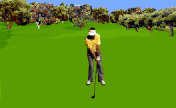 Are you a golfer or a player? Here’s the difference: A golfer gets up on the first tee thinking about arm angles,?plane,?rotation and a lot of other ‘swing thoughts’.
Are you a golfer or a player? Here’s the difference: A golfer gets up on the first tee thinking about arm angles,?plane,?rotation and a lot of other ‘swing thoughts’.
A player steps up to the first tee thinking how he or she?is going to take whatever swing they have and use playing strategy and smarts to get the most out of their skills.?Imagine how?you’d do at chess if you spent all your time learning to move the pieces, but studied nothing on strategy and tactics!
If being a player instead of a golfer?resonates with?you, then Laird Small, Director of the Pebble Beach Golf Academy has?written a book that?will help tremendously. This book is about learning to be a player.
Play Golf The Pebble Beach Way is packed with strategy that?Laird, a PGA Teacher of the Year,?has?gleaned over a lifetime of playing and teaching.?It’s also contains plenty of anecdotes?he’s?heard from the game’s greats that helped them play the ‘smart’ golf that made them champions.
The book starts with a how-to on conquering?first tee jitters. This is a problem faced by every golfer, even the best players in the world – ask Corey Pavin about teeing it up his first time at a Ryder Cup. Often that first swing sets a mood for the?early?holes and can be the difference between a good start and one that leaves you in a self-made hole.
Laird gives you 7 lessons that will help you keep it in play even if your legs feel like limp noodles because you’re playing in front of thousands at?a Pebble Beach Pro-Am! The remaining chapters address every aspect of playing smarter golf. For a look at the table of contents click HERE.
One of the things that makes this book so different is that all of the teaching is?applied to the holes at Pebble Beach with plenty of great pictures to clarify points. This is particularly helpful in?visualizing how to correctly use strategy. (It also makes you drool to play Pebble Beach.)?It’s very interesting to compare Laird’s comments?on?how to play each?hole?to what happened to specific players during this year’s?U.S. Open.
After reading the book?from cover to cover, I thought it was a shame that?the approach?wasn’t incorporated into this year’s Open Amateur Challenge to see if a 10 handicapper could break 100 playing the?Open setup. How interesting it would have been to see?what two players working with Laird for a few days on strategy would have done versus two who didn’t. The PGA?should consider?it for next year as it behooves them to help amateurs learn to play better.
I was fortunate enough to get some time on the phone with Laird to ask him why he wrote the book. It was primarily in response to the well established fact that amateur golfers haven’t improved a lick in 30 years even though there has been an explosion in technology and enough golf ‘how-to swing’ articles and books to fill a small warehouse.?He believes that too much time is spent on swing mechanics and?too little on learning game strategy. Sound like you?
Most sports in this country have pretty good junior programs that teach kids skills and mechanics, but also how to ‘play the game’. Unfortunately this is not generally the case in golf. Nowadays many golfers don’t take up the sport until after 20 and never formerly learn any playing strategy or even the rules! Most could knock 6-10 strokes off their round with their existing swing if they just?played smarter.
I have only a few issues with the book and they are primarily cosmetic. There should have been more white space in the layout, it’s a little claustrophobic.?The summaries of each chapters lessons should be at the end, not after the first page. It would have been helpful if Laird hand included an upfront?strategy for integrating all the advice?in an organized way into?ones game.
On the whole, this is a great book for anyone who’s serious about the game, even playing pros. It’s a significant work because it addresses an area of golf that has been neglected in this country for too long. If you practice what Laird is teaching you’ll score better, but more importantly you’ll have more fun. I’ve already benefited from tips I’ve picked up. For instance, when you have limited time to warm up before a round, practice lag putting to a general area – not a hole.
Then sink a few 4 foot putts and you’re ready to go. I’ve started doing this and have consistently had better speed control right out of the box. Do yourself a favor, forget about swing mechanics for awhile?and read this book! The chapter on ‘How to Major in Architecture’ is worth the price alone. You’ll have a much better idea of how the course architect is trying to get the better of you on each hole.
Related posts: Hitting It PureUnabashed Advice On Learning to Play GolfWe Can Figure How To Play BetterSlow PlayScot Duke Interview On His New Book – "How to Play Business Golf"
If you enjoyed this post, please consider to leave a comment or subscribe to the feed and get future articles delivered to your feed reader.





No comments:
Post a Comment